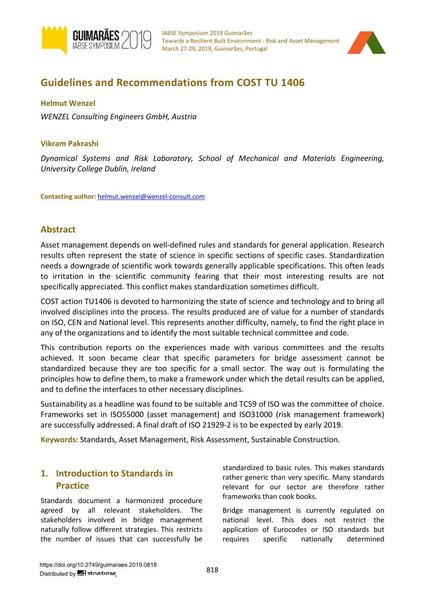Guidelines and Recommendations from COST TU 1406

|
|
|||||||||||
Détails bibliographiques
| Auteur(s): |
Helmut Wenzel
(WENZEL Consulting Engineers GmbH, Austria)
Vikram Pakrashi (Dynamical Systems and Risk Laboratory, School of Mechanical and Materials Engineering, University College Dublin, Ireland) |
||||
|---|---|---|---|---|---|
| Médium: | papier de conférence | ||||
| Langue(s): | anglais | ||||
| Conférence: | IABSE Symposium: Towards a Resilient Built Environment Risk and Asset Management, Guimarães, Portugal, 27-29 March 2019 | ||||
| Publié dans: | IABSE Symposium Guimarães 2019 | ||||
|
|||||
| Page(s): | 818-824 | ||||
| Nombre total de pages (du PDF): | 7 | ||||
| DOI: | 10.2749/guimaraes.2019.0818 | ||||
| Abstrait: |
Asset management depends on well-defined rules and standards for general application. Research results often represent the state of science in specific sections of specific cases. Standardization needs a downgrade of scientific work towards generally applicable specifications. This often leads to irritation in the scientific community fearing that their most interesting results are not specifically appreciated. This conflict makes standardization sometimes difficult. COST action TU1406 is devoted to harmonizing the state of science and technology and to bring all involved disciplines into the process. The results produced are of value for a number of standards on ISO, CEN and National level. This represents another difficulty, namely, to find the right place in any of the organizations and to identify the most suitable technical committee and code. This contribution reports on the experiences made with various committees and the results achieved. It soon became clear that specific parameters for bridge assessment cannot be standardized because they are too specific for a small sector. The way out is formulating the principles how to define them, to make a framework under which the detail results can be applied, and to define the interfaces to other necessary disciplines. Sustainability as a headline was found to be suitable and TC59 of ISO was the committee of choice. Frameworks set in ISO55000 (asset management) and ISO31000 (risk management framework) are successfully addressed. A final draft of ISO 21929-2 is to be expected by early 2019. |
||||
